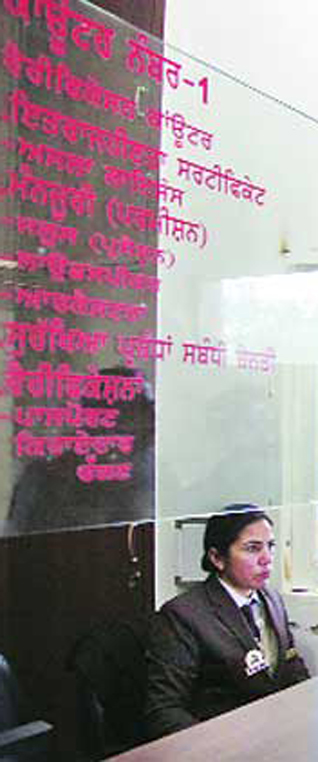Current Events
A New Public Face For Punjab Police
KANCHEN VASDEV
It’s chilly, windy and rainy. On top of such weather, Phool Bibi’s son Mirza Talib has just lost his wallet and all the valuables in it -- his money, his ID card, his vehicle’s registration certificate and his driving licence.
Adjusting her half-wet salwar-kameez and folding her umbrella, the 50-year-old admits she was dreading the prospect of going to a police station to file a complaint for theft.
“Thankfully, they sent me here,” says Bibi, walking into a centre that looks nothing like a regular police station -- no yellow building and no red-and-blue boards.
The “saanjh kendra” or “Police Station Outreach Centre” where Bibi has arrived to register her complaint is a swanky, steel building with neat, well-marked-out counters and an LCD TV inside.
At first Bibi, who calls herself “not too worldly wise”, is slightly intimidated at this stark change from a police station. Then the receptionist directs her to two counters -- at one is a woman constable and at the other, her male counterpart. Both are dressed in crisp white shirts, brown blazers, and brown ties. The only khaki element they retain are their trousers.
It is noon and there is no queue. The woman constable, Karamveer Kaur, smiles at Bibi and gives her a Daily Diary Report (DDR) form to fill. Bibi sits on one of the plastic chairs arranged in a row, and fills out the details -- name, age, complaint, address, etc.
She submits it to Constable Karamveer Kaur, who copies the information onto a computer and sends it to the central server of the Punjab Police, from where it can be accessed by the police station in whose jurisdiction the loss/theft took place. She gives Bibi a receipt of the DDR and informs her that she would have to approach the police station for follow-ups on her complaint.
Soon, more people have walked in. Simranjit Kaur, a BDS student, has come to register a complaint for her mother’s lost/stolen ATM card, while Lakhwinder Singh and Amarjeet Singh are here to report the loss of their cellphones. Constable Karamveer Kaur repeats the procedure with each.
This saanjh kendra in Phase-1 Mohali handles, on an average, 50 walk-ins every day. Set up in 2012 by the Punjab government, the 363 saanjh kendras across the state deal with registration of foreigners, investigation of cases of missing passports, complaints of fraud by travel agents, tourist complaints, tenant verification, registration and investigation of servants, passport verification, police clearance certificate at time of foreign immigration, apart from other minor clearances.
Only heinous crimes such as murder, rape, abduction or drug trafficking are left to be handled by police stations.
“Besides reducing the workload of police stations, we also spare people inconvenience,” says sub-inspector Narinder Singh who is in charge of the Phase-1 saanjh kendra. Each centre is headed by a sub-inspector and has at least two constables, one of them a woman, along with a receptionist.
“The minimum educational requirement for the constable is senior secondary education. We train them in computers and communication skills for two weeks,” says Narinder Singh.
The centres are self-sustaining, with operating costs, including staff salaries, phone/electricity bills and computer maintenance, compensated by the collection of fees -- complainants are charged between Rs 5 and Rs 200 for services offered.
Having uploaded some 25 complaints by 2 pm, Constable Karamveer Kaur takes a lunch break.
“I joined the police department three years ago but for the last two years, I am with this centre. I was trained for 15 days in public dealing as well as computers before I was assigned here,” she says. Though she feels that this work is “less challenging” than being deployed at a police station”, she prefers the saanjh kendra. “It’s a 9-5 job, and suits me because I have two little children.”
The Phase-1 centre is among the “busiest” saanjh kendras. But the numbers don’t yet suggest a hectic schedule.
“Between September 17, 2012, and May 1, 2014,” says Narinder Singh, “the centre issued 9,469 DDRs, carried out 6,779 tenant verifications, 322 service verifications, 547 character verifications, 5,440 passport verifications and offered services to 23,285 people”.
Perhaps, it’s because the centres only help a person with the first step in dealing with the police. The next visit has to be to the police station.
[Courtesy: Indian Express. Edited for sikhchic.com]
January 18, 2015
Conversation about this article
1: Harcharan Singh (Singapore), January 18, 2015, 10:58 PM.
It takes the government about more then 50 years to realise that this can be done? Either they never thought of this before or they didn't want to channel resources for such a project. Or all of the above? Politicians being paid and voted to do nothing for the country?
2: Sunny Grewal (Abbotsford, British Columbia, Canada), January 19, 2015, 4:08 AM.
The station in this article handles minor crimes. The article goes on to say that rape, murder and abduction are handled by the traditional police stations. So who does the common man report to when it is the police officers engaging in rape, murder and abductions? Never mind, we are dealing with the Punjab police force, our boys in khaki, they would never resort to such level of criminality, would they?



